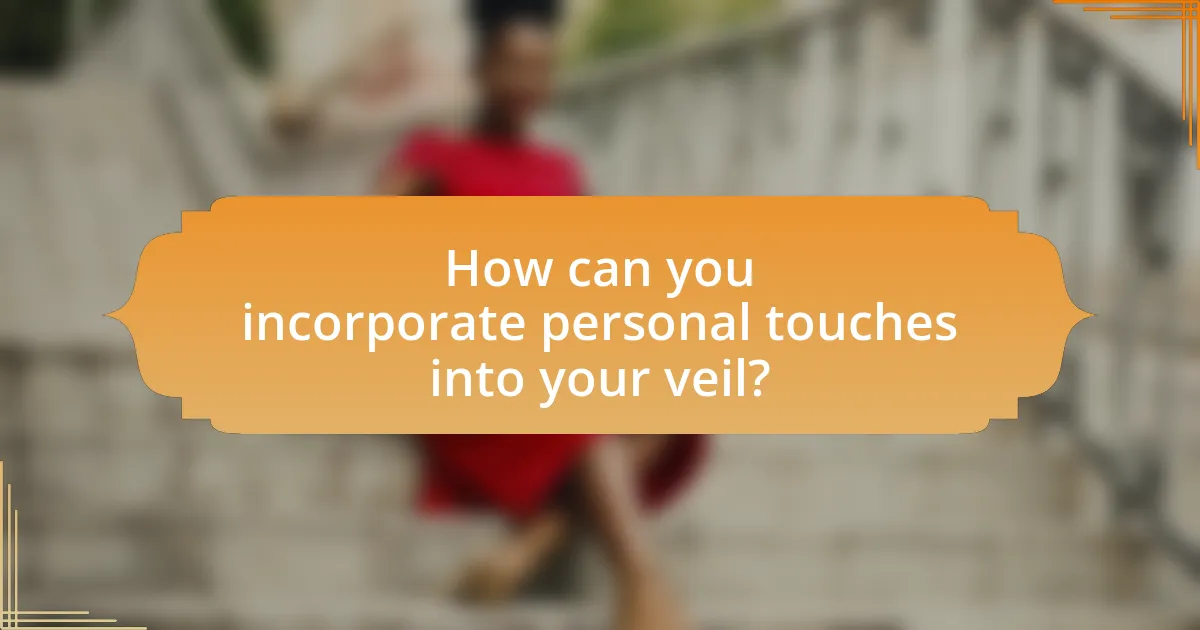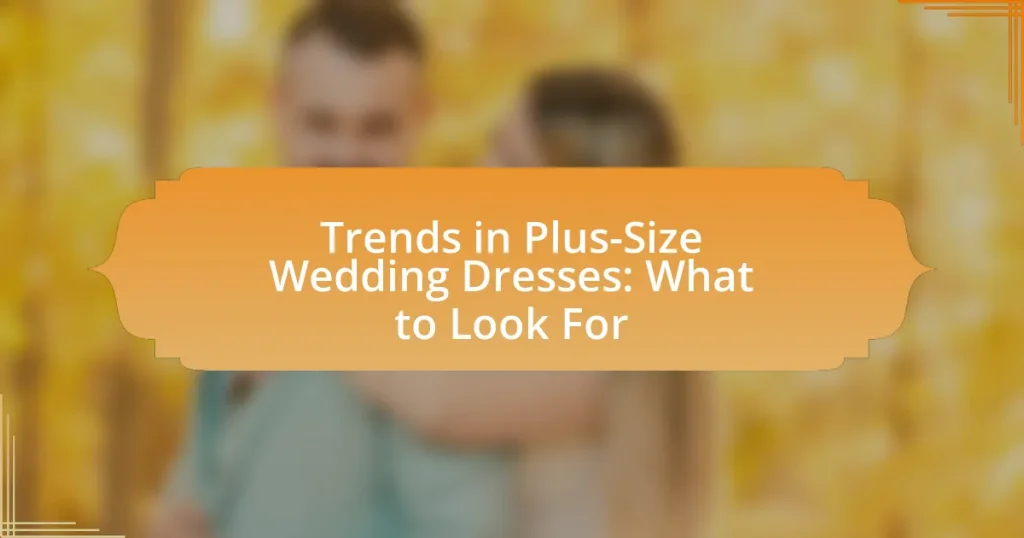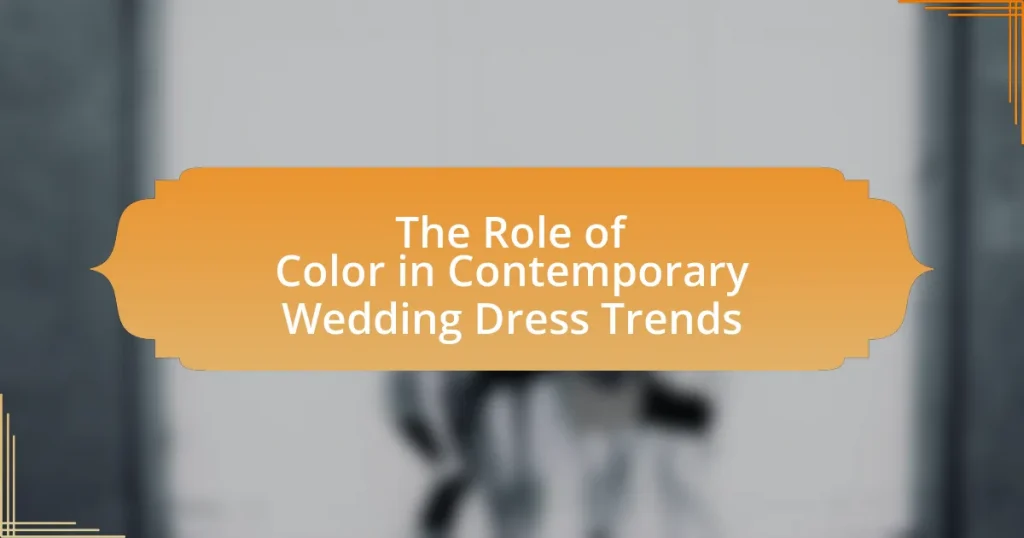The article focuses on the customization of bridal veils, highlighting key elements such as fabric selection, length, style, embellishments, and color. It discusses how fabric choice influences the veil’s appearance and offers insights into popular materials like tulle, lace, and silk. The article also explores various embellishments, including beading and embroidery, that can personalize a veil, as well as different veil styles like cathedral and fingertip. Additionally, it addresses practical considerations for ensuring the veil complements the wedding dress and provides budget-friendly tips for customization. Overall, the content serves as a comprehensive guide for brides looking to create a unique and personalized veil for their wedding day.

What are the key elements of customizing your veil?
The key elements of customizing your veil include fabric selection, length and style, embellishments, and color. Fabric selection is crucial as it affects the veil’s drape and overall appearance; popular choices include tulle, lace, and silk. Length and style should align with the wedding theme and personal preference, with options ranging from birdcage to cathedral lengths. Embellishments such as beading, embroidery, or appliqués can add unique details, enhancing the veil’s visual appeal. Finally, color customization allows the veil to complement the wedding dress and overall color scheme, with options ranging from traditional white to more vibrant hues.
How can fabric choice influence the customization of your veil?
Fabric choice significantly influences the customization of a veil by determining its texture, drape, and overall aesthetic. Different fabrics, such as tulle, lace, or silk, offer unique characteristics that can enhance or alter the design elements of the veil. For instance, tulle provides a light and airy feel, making it suitable for voluminous styles, while lace adds intricate detailing and a vintage touch. Additionally, the weight and opacity of the fabric can affect how the veil layers and interacts with other elements of the bridal ensemble, allowing for personalized adjustments in length, embellishments, and overall style.
What types of fabrics are popular for veils?
Popular fabrics for veils include tulle, lace, chiffon, and organza. Tulle is favored for its lightweight and airy quality, making it ideal for creating a soft, ethereal look. Lace adds a touch of elegance and intricate detail, often used for more formal or vintage styles. Chiffon is known for its flowy and delicate nature, providing a romantic appearance, while organza offers a crisp and structured look, often used for dramatic effects. These fabrics are commonly chosen for their aesthetic appeal and versatility in veil design.
How does the weight of the fabric affect the veil’s appearance?
The weight of the fabric significantly influences the veil’s appearance by determining its drape, flow, and overall silhouette. Heavier fabrics, such as satin or tulle, create a structured look that can add volume and presence, while lighter fabrics, like chiffon or organza, produce a softer, more ethereal effect. For instance, a veil made from a heavier material may stand out more prominently against a gown, enhancing the overall bridal aesthetic, whereas a lightweight veil can create a delicate, airy appearance that complements a more understated dress. This relationship between fabric weight and visual impact is crucial for achieving the desired style in veil customization.
What embellishments can be added to personalize your veil?
Embellishments that can be added to personalize your veil include lace trim, beading, embroidery, and floral appliqués. Lace trim adds a classic and elegant touch, while beading can create a sparkling effect that enhances the overall look. Embroidery allows for intricate designs or monograms, making the veil unique to the wearer. Floral appliqués can introduce a three-dimensional aspect and can be tailored to match the wedding theme or bouquet. These options provide a variety of ways to customize a veil, ensuring it reflects the individual’s style and personality.
Which types of lace are suitable for veil customization?
Chantilly lace, Alençon lace, and Venetian lace are suitable for veil customization. Chantilly lace is known for its delicate floral patterns and fine netting, making it a popular choice for veils. Alençon lace features a distinctive floral design with a heavier thread, providing a more structured look. Venetian lace, characterized by its intricate designs and bold patterns, adds a dramatic touch to veils. These types of lace not only enhance the aesthetic appeal of veils but also allow for personalization through various designs and embellishments.
How can beading enhance the overall look of a veil?
Beading enhances the overall look of a veil by adding texture, sparkle, and visual interest. The intricate designs created by beads can transform a simple veil into a statement piece, drawing attention and elevating the overall aesthetic. For instance, beaded embellishments can reflect light beautifully, creating a shimmering effect that enhances the veil’s elegance. Additionally, beading can complement the gown’s details, creating a cohesive look that ties the entire outfit together. This customization option allows for personal expression, making the veil unique to the wearer.
What styles of veils can be customized?
Various styles of veils can be customized, including cathedral, chapel, fingertip, and birdcage veils. Each of these styles allows for personalization in terms of length, fabric, embellishments, and design elements. For instance, cathedral veils can be tailored with lace trim or embroidery, while fingertip veils can feature beading or floral appliqués, providing brides with the opportunity to create a unique look that reflects their personal style.
What are the differences between cathedral, chapel, and fingertip veils?
Cathedral, chapel, and fingertip veils differ primarily in their lengths and styles. Cathedral veils are the longest, typically extending beyond the train of the wedding gown, creating a dramatic effect. Chapel veils are shorter than cathedral veils, usually reaching the floor but not trailing significantly, offering a more understated elegance. Fingertip veils are the shortest, designed to reach the bride’s fingertips, providing a classic and simple look. These distinctions in length and style cater to various bridal aesthetics and preferences, allowing brides to customize their veils to match their overall wedding theme.
How does the length of the veil impact customization options?
The length of the veil significantly impacts customization options by determining the style, embellishments, and overall aesthetic of the bridal look. Longer veils, such as cathedral or chapel lengths, allow for more intricate designs and embellishments like lace, beading, or embroidery, enhancing the visual impact. In contrast, shorter veils, like birdcage or fingertip lengths, typically offer simpler designs, focusing on minimalistic elegance. This distinction influences how brides can personalize their veils to match their wedding theme and dress style, as longer veils can create a dramatic effect while shorter veils may complement a more casual or modern look.

How can you incorporate personal touches into your veil?
To incorporate personal touches into your veil, consider adding custom embroidery or embellishments that reflect your personality or heritage. For example, you can include initials, a meaningful date, or symbols that hold significance to you, which can be stitched into the fabric. This practice is supported by the trend of personalized wedding accessories, where 30% of brides opt for custom designs to enhance their unique style. Additionally, using fabric from a family heirloom or incorporating colors that represent your family can further personalize your veil, making it a cherished keepsake.
What are some creative ways to add personal symbols to your veil?
To add personal symbols to your veil, consider incorporating embroidered initials, meaningful dates, or family crests. Embroidery allows for intricate designs that can represent your identity or heritage, making the veil uniquely yours. For example, a bride might choose to stitch her and her partner’s initials in a decorative font at the edge of the veil, creating a lasting memory. Additionally, attaching charms or small fabric patches that symbolize significant moments or relationships can enhance the veil’s personal significance. These methods not only personalize the veil but also create a tangible connection to your story and values.
How can embroidery reflect personal stories or heritage?
Embroidery can reflect personal stories or heritage by incorporating symbols, patterns, and colors that hold specific meanings to the individual or their culture. For instance, traditional motifs may represent family lineage, cultural identity, or significant life events, allowing the wearer to express their unique background. Historical practices show that many cultures use embroidery to tell stories; for example, in many Indigenous communities, specific designs are passed down through generations, signifying tribal affiliation and personal narratives. This connection between embroidery and personal heritage is evident in various cultures, where embroidered textiles serve as a canvas for storytelling and identity representation.
What types of appliqués can be used for a unique design?
Various types of appliqués can be used for a unique design, including lace, embroidered, beaded, and fabric appliqués. Lace appliqués add a delicate and intricate touch, often used to create a vintage or romantic look. Embroidered appliqués can feature personalized designs or motifs, enhancing the individuality of the piece. Beaded appliqués introduce texture and sparkle, making the design more eye-catching. Fabric appliqués, made from different textiles, allow for creative layering and color combinations, contributing to a distinctive aesthetic. Each type of appliqué serves to personalize and elevate the overall design of the veil, making it a unique expression of style.
How can color choices personalize your veil?
Color choices can personalize your veil by reflecting individual style, cultural significance, or thematic elements of an event. For instance, selecting a specific color can symbolize emotions or traditions; white often represents purity in Western cultures, while red may signify good fortune in some Asian cultures. Additionally, custom colors can align with wedding themes or personal preferences, allowing the veil to complement the overall attire and setting. This personalization enhances the emotional connection to the veil, making it a unique representation of the wearer’s identity and values.
What are the trending colors for veils today?
The trending colors for veils today include soft pastels like blush pink and lavender, as well as classic shades such as ivory and white. These colors are popular due to their versatility and ability to complement various wedding themes. Additionally, deeper hues like navy blue and burgundy are gaining traction for those seeking a bolder statement. The preference for these colors reflects current bridal fashion trends, which emphasize personalization and unique expressions of style.
How can you match your veil color with your wedding theme?
To match your veil color with your wedding theme, select a veil hue that complements the primary colors of your wedding palette. For instance, if your theme features soft pastels, opt for a veil in a similar light shade, such as blush or ivory, to create a cohesive look. Conversely, if your theme includes bold colors, consider a veil that incorporates those shades, like a deep red or navy, to enhance the overall aesthetic. This approach ensures that the veil harmonizes with the bridal gown and other decor elements, creating a unified visual experience for the event.

What practical considerations should you keep in mind when customizing your veil?
When customizing your veil, consider the fabric, length, and style to ensure it complements your overall look. The choice of fabric affects the veil’s drape and appearance; for example, lace adds elegance while tulle offers a lighter feel. The length should align with your dress style and personal preference, as longer veils can create a dramatic effect, while shorter ones may provide a more modern look. Additionally, the style of the veil should harmonize with your hairstyle and accessories, ensuring a cohesive appearance. These considerations are essential for achieving a personalized and visually appealing result.
How do you ensure the veil complements your wedding dress?
To ensure the veil complements your wedding dress, select a veil that matches the dress’s fabric, color, and style. For instance, if your dress is made of lace, a lace veil will create a cohesive look. Additionally, consider the length and shape of the veil; a long, flowing veil pairs well with a formal gown, while a shorter veil suits a more casual dress. Color matching is crucial; a veil in the same shade as the dress or a complementary tone enhances the overall aesthetic. This approach is supported by bridal fashion experts who emphasize the importance of harmony between the veil and dress for a unified bridal look.
What factors should you consider regarding the dress’s neckline?
When considering a dress’s neckline, factors such as body shape, style of the dress, and occasion are crucial. Body shape influences which neckline flatters the figure; for example, a V-neck can elongate the torso for pear-shaped individuals, while an off-the-shoulder style may enhance the shoulders for an hourglass figure. The style of the dress, whether it is formal or casual, also dictates the appropriate neckline; a high neckline may suit a more conservative look, while a plunging neckline can be more suitable for evening events. Lastly, the occasion plays a significant role; for weddings, a sweetheart neckline is popular, while a boat neckline may be preferred for more formal gatherings. These considerations ensure that the neckline complements both the wearer’s physique and the event’s atmosphere.
How can the dress’s style influence veil length and design?
The dress’s style significantly influences veil length and design by dictating the overall aesthetic and formality of the bridal look. For instance, a ball gown typically pairs well with a longer veil, such as a cathedral veil, to complement its dramatic silhouette, while a sleek, modern sheath dress may be better suited to a shorter veil, like a birdcage or fingertip length, to maintain a streamlined appearance. Additionally, the embellishments on the dress, such as lace or beading, can inspire the veil’s design, encouraging brides to choose veils that incorporate similar details for a cohesive look. This relationship between dress and veil ensures that the overall bridal ensemble is harmonious and visually appealing.
What budget considerations are important for veil customization?
Budget considerations for veil customization include material costs, design complexity, and additional embellishments. High-quality fabrics such as silk or lace typically increase the overall expense, while simpler designs may be more affordable. Furthermore, intricate details like embroidery or beading can significantly raise the price, as they require more labor and time. According to industry standards, custom veils can range from $50 to over $500, depending on these factors, making it essential for individuals to prioritize their preferences and budget constraints when planning their customization.
How can you prioritize customization options within your budget?
To prioritize customization options within your budget, first, identify the essential features that align with your personal style and needs. Focus on the most impactful elements, such as fabric choice, design details, and embellishments, which can significantly enhance the overall look of your veil. Next, allocate a specific portion of your budget to each feature based on its importance to you, ensuring that you do not overspend on less critical aspects. For instance, if intricate lace detailing is a priority, consider reducing costs in other areas, like opting for simpler fabric. Research shows that setting clear priorities can lead to more satisfying customization outcomes while adhering to budget constraints, as evidenced by studies in consumer behavior that highlight the effectiveness of budget allocation strategies.
What are some cost-effective ways to personalize your veil?
Cost-effective ways to personalize your veil include adding embellishments like lace trim, fabric flowers, or beads, which can be sourced from craft stores. These additions allow for customization without significant expense. For instance, lace can be purchased for as little as $5 per yard, and fabric flowers can be made or bought for under $10. Additionally, hand-embroidering initials or a meaningful date onto the veil can create a unique touch, with embroidery thread costing around $2. Using these methods not only enhances the veil’s appearance but also maintains a budget-friendly approach.
What tips can help you successfully customize your veil?
To successfully customize your veil, consider selecting a fabric that complements your dress, such as lace or tulle, which can enhance the overall aesthetic. Additionally, incorporating personal elements like embroidery or beading can add a unique touch that reflects your style. Research shows that brides who personalize their veils often feel a stronger connection to their wedding attire, enhancing their overall experience.
How can you work effectively with a designer for your veil?
To work effectively with a designer for your veil, clearly communicate your vision and preferences from the outset. This involves sharing specific details such as the style, length, fabric, and any embellishments you desire. Providing visual references, like photos or sketches, can help the designer understand your aesthetic better. Additionally, maintaining open lines of communication throughout the design process allows for adjustments and ensures that the final product aligns with your expectations. Engaging in regular check-ins and being receptive to the designer’s expertise can enhance collaboration and lead to a more personalized and unique veil.
What are the common mistakes to avoid when customizing a veil?
Common mistakes to avoid when customizing a veil include neglecting to consider the overall wedding theme, failing to choose the right length and style for the dress, and overlooking the importance of fabric choice. Not aligning the veil with the dress can create a disjointed look, as the veil should complement the gown’s design. Additionally, selecting an inappropriate length can affect the overall silhouette; for instance, a long veil may overwhelm a simple dress. Lastly, choosing the wrong fabric can impact the veil’s drape and appearance; for example, a heavy fabric may not flow well with a lightweight dress.



